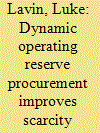| Srl | Item |
| 1 |
ID:
177111


|
|
|
|
|
| Summary/Abstract |
Competitive electricity markets can procure reserve generation through a market in which the demand for reserves is administratively established. A downward sloping or stepped administrative demand curve is commonly termed an operating reserve demand curve (ORDC). We propose a dynamic formulation of an ORDC with generator forced outage probabilities conditional on ambient temperature to implement scarcity pricing in a wholesale electricity market. This formulation improves on common existing methods used by wholesale market operators to articulate ORDCs by explicitly accounting for a large source of observed variability in generator forced outages, whereby for a fixed load, more reserves are required during times of extreme heat and cold to maintain a constant risk of reserve shortage. Such a dynamic ORDC increases social welfare by $17.1 million compared to current practice in the PJM Interconnection during a high load week in a welfare-maximizing electricity market with co-optimized procurement of energy and reserves. A dynamic ORDC increases reserve prices under scarcity conditions, but has minimal effects on total market payments. The results are directly relevant to the modeled two-settlement electricity market in PJM, which is currently undergoing enhancements to its ORDC.
|
|
|
|
|
|
|
|
|
|
|
|
|
|
|
|
| 2 |
ID:
177319


|
|
|
|
|
| Summary/Abstract |
Resolving the resource adequacy problem has been usually entrusted to the imposition of some kind of long-term capacity requirements or to forward markets. The Operating Reserve Demand Curve (ORDC), which is linked to short-term market conditions and does not require central planning, has been presented as an alternative system with which to ensure long-term resource adequacy in the market. Using hourly data from the Texas ERCOT market between January 2015 and February 2019, we empirically show that ORDC prices are significantly negatively affected by wind generation. We find that, if wind generation is relatively low, a 1% increase in wind generation decreases the ORDC price by around 0.15–0.1%. This fact may preclude the ORDC from providing long-term price signals and price stability to generators. Moreover, we also find that if wind generation is greater than 9000 MW, the ORDC price is expected to be zero, which may further disincentive to increase generation capacity –especially dispatchable capacity that may be needed as a backup if the wind is not blowing.
|
|
|
|
|
|
|
|
|
|
|
|
|
|
|
|